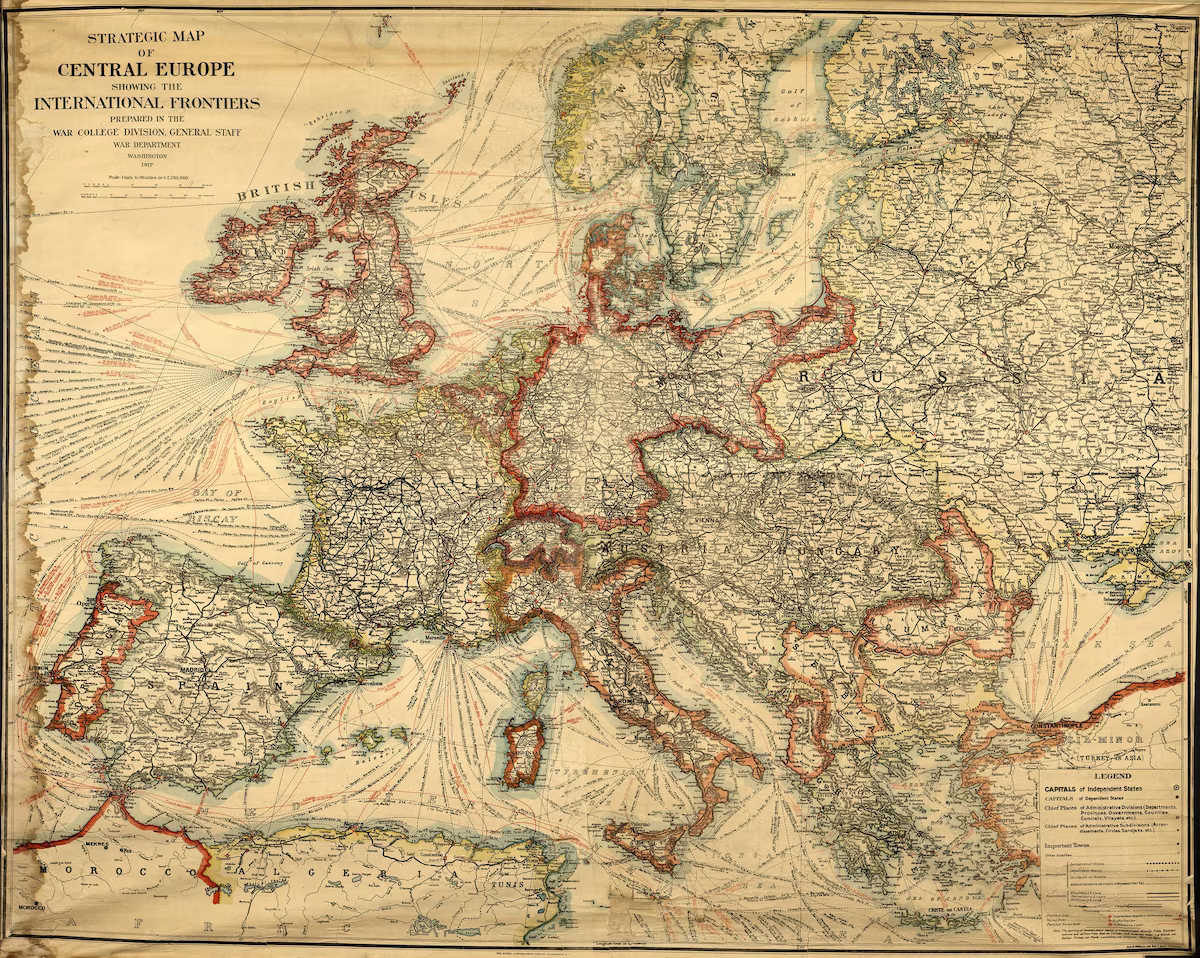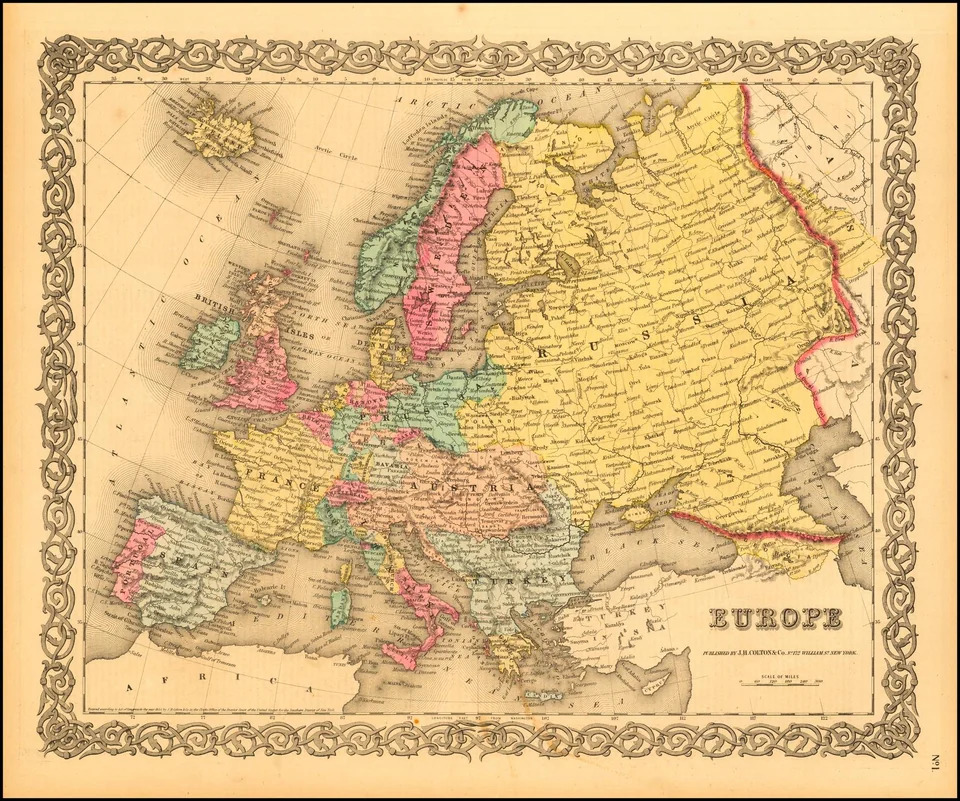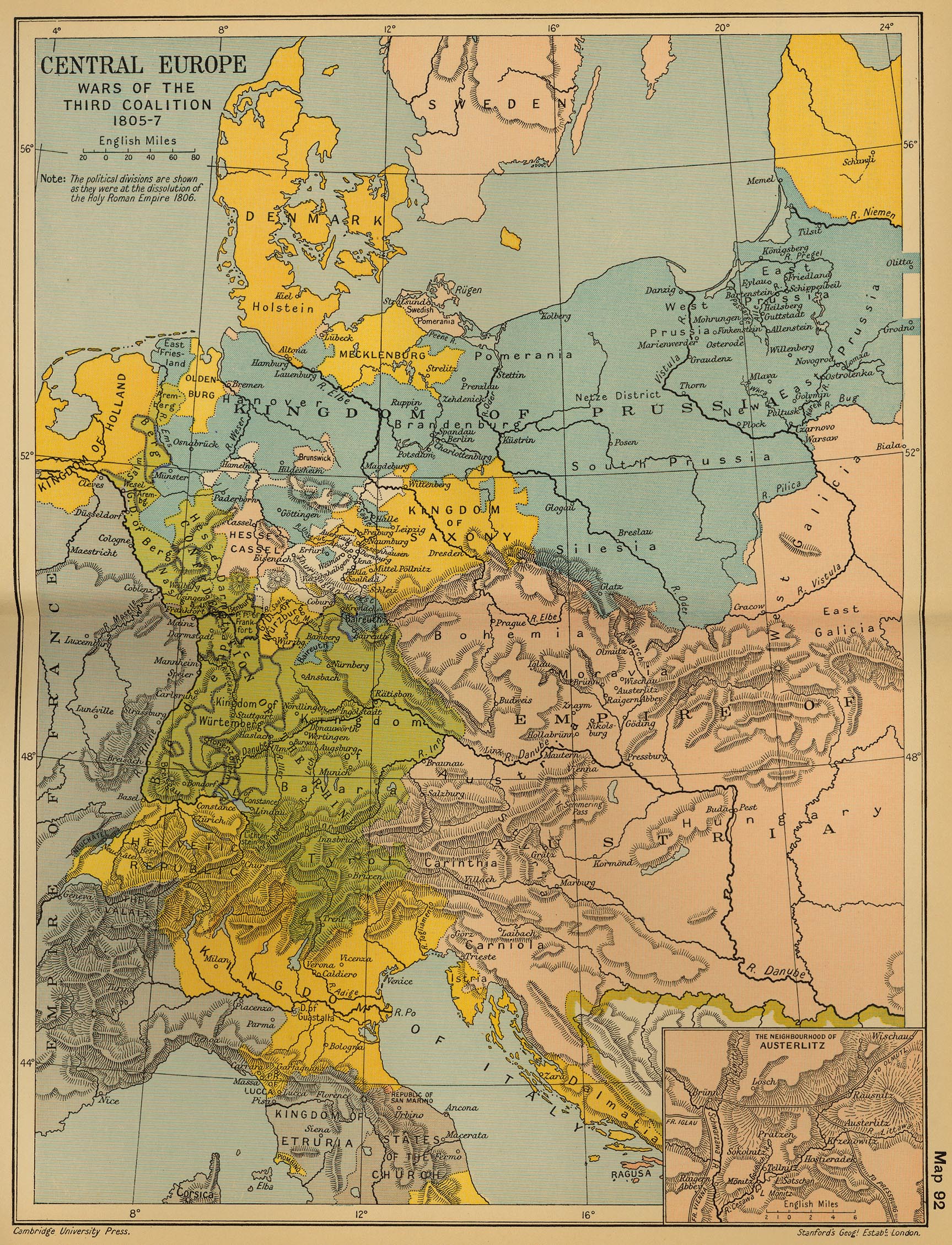flexibeast.space - miscellaneous
Some history ignored or erased in certain discussions
Here's a map of Europe in 1917:
Here's a map of Europe in 1859:
Here's a map of Europe in 1806:
‘Poland’ does not exist as a distinct country on any of those maps; at most, as on the 1859 map, it's a mere region of Russia. So was the creation of Poland in 1918:
Wikipedia: ‘Second Polish Republic’
simply the creation of a country that had never actually existed in that location before? Was everyone in the ‘Poland’ region of Russia actually ‘really’ just Russian?
As the name ‘Second Polish Republic’ implies: No. Poland - or more specifically, the Polish-Lithuanian Commonwealth - disappeared off maps after the Third Partition of Poland by Prussia, the Habsburg Monarchy and Russia in 1795, in response to the Kościusko Uprising[a]:
Wikipedia: ‘Third Partition of Poland’
i mention the preceding because a number of leftists, implicitly or explicitly, assert or support the notion that there has never been any actual historical ‘Israel’ in the Levant; that it was created out of whole cloth, based solely on Jewish scripture/mythology, in 1948. Well, no:
Wikipedia: ‘History of ancient Israel and Judah’
Wikipedia: ‘Second Temple period’
The Kingdom of Israel was founded around 900 BCE (‘Before Christian/Common Era’, i.e. 900 ‘BC’); the Kingdom of Judah was destroyed by the Babylonians in 586 BCE, resulting in the exile of Jews into the Babylonian Captivity (cf. “By the rivers of Babylon”). After the fall of the Babylonian Empire to Cyrus the Great in 539 BCE, Jews were permitted to start to return to Judah; construction of the Second Temple in Jerusalem began in 537 BCE in what was then the Persian province of ‘Yehuda Medinata’.
The lands of the former Kingdom of Israel and Kingdom of Judah (c. 722–586 BCE), had been occupied in turn by Assyria, Babylonia, the Achaemenid Empire, and Alexander the Great's Hellenic Macedonian empire (c. 330 BCE), although Jewish religious practice and culture had persisted and even flourished during certain periods. The entire region was heavily contested between the successor states of Alexander's empire, the Seleucid Empire and Ptolemaic Egypt, during the six Syrian Wars of the 3rd–1st centuries BCE: "After two centuries of peace under the Persians, the Hebrew state found itself once more caught in the middle of power struggles between two great empires: the Seleucid state with its capital in Syria to the north and the Ptolemaic state, with its capital in Egypt to the south...Between 319 and 302 BC, Jerusalem changed hands seven times."
— Wikipedia: ‘Hasmonean dynasty’
Rome conquered the region they called ‘Judaea’ in 63 BCE, turning the Jewish Hasmonean Kingdom, which had become an independent entity in 110 BCE, into a Roman protectorate. Roughly two hundred years later, in 70 CE (‘Christian/Common Era’, i.e. 70 ‘AD’), Rome destroyed the Second Temple, marking the beginning of a new and large Jewish diasporic wave:
According to Josephus, about 97,000 Jewish captives from Judea were sold into slavery by the Romans during the revolt. Many other Jews fled from Judea to other areas around the Mediterranean. Josephus wrote that 30,000 Jews were deported from Judea to Carthage by the Romans.
— Wikipedia: ‘Jewish diaspora’
Then, after the Bar Kokhba Revolt between 132 and 136 CE:
Wikipedia: ‘Bar Kokhba revolt’
Jews were forbidden to access Jerusalem; Jerusalem itself was renamed Aelia Capitolina; and Rome merged the province of ‘Judaea’ - named after the 6th century BCE Kingdom of Judah - with the province of ‘Galilee’ to create the province ‘Syria Palaestina’:
The military defeats of the Jews in Judaea in 70 CE and again in 135 CE, with large numbers of Jewish captives from Judea sold into slavery and an increase in voluntary Jewish emigration from Judea as a result of the wars, meant a drop in Palestine's Jewish population was balanced by a rise in diaspora numbers. Jewish prisoners sold as slaves in the diaspora and their children were eventually manumitted and joined local free communities. It has been argued that the archaeological evidence is suggestive of a Roman genocide taking place during the Second revolt.
— Wikipedia: ‘Jewish diaspora’
Thus, the reason there was no ‘Israel’ on the map of the Levant in 1947 is primarily due to the actions of the Roman Empire, followed by centuries of persecution of the Jewish diaspora in Europe by Christians[b]:
Wikipedia: ‘Timeline of antisemitism’
Muslim Arabs conquered the Levant around the mid-600s CE:
Wikipedia: ‘Muslim conquest of the Levant’
and the Temple Mount, the site of the Jewish Second Temple that had been destroyed by the Romans, became the site of the Al-Aqsa mosque:
Nonetheless, a much-reduced Jewish community remained in the area, and in the Middle East more generally; these Jews are known as ‘Mizrahim’. Isaac Luria, a significant figure in the history of Kabbalah, lived in Safed in the 1500s; by the end of the 1800s, that town was a mix of Jews and Muslims.
The Jewish diaspora in Eastern Europe were the ‘Ashkenazim‘. The Ashkenazim were subjected to repeated pogroms. Quoting Wikipedia at length:
The Russian Empire, which previously had very few Jews, acquired territories in the Russian Partition that contained large Jewish populations, during the military partitions of Poland in 1772, 1793 and 1795. In conquered territories, a new political entity called the Pale of Settlement was formed in 1791 by Catherine the Great. Most Jews from the former Commonwealth were allowed to reside only within the Pale, including families expelled by royal decree from St. Petersburg, Moscow and other large Russian cities. The 1821 Odessa pogroms marked the beginning of the 19th century pogroms in Tsarist Russia; there were four more such pogroms in Odessa before the end of the century. Following the assassination of Alexander II in 1881 by Narodnaya Volya, anti-Jewish events turned into a wave of over 200 pogroms by their modern definition, which lasted for several years. Jewish self-governing Kehillah were abolished by Tsar Nicholas I in 1844.
The first in 20th-century Russia was the Kishinev pogrom of 1903 in which 49 Jews were killed, hundreds wounded, 700 homes destroyed and 600 businesses pillaged. In the same year, pogroms took place in Gomel (Belarus), Smela, Feodosiya and Melitopol (Ukraine). Extreme savagery was typified by mutilations of the wounded. They were followed by the Zhitomir pogrom (with 29 killed), and the Kiev pogrom of October 1905 resulting in a massacre of approximately 100 Jews. In three years between 1903 and 1906, about 660 pogroms were recorded in Ukraine and Bessarabia; half a dozen more in Belorussia, carried out with the Russian government's complicity, but no anti-Jewish pogroms were recorded in Poland. At about that time, the Jewish Labor Bund began organizing armed self-defense units ready to shoot back, and the pogroms subsided for a number of years. According to professor Colin Tatz, between 1881 and 1920 there were 1,326 pogroms in Ukraine (see: Southwestern Krai parts of the Pale) which took the lives of 70,000 to 250,000 civilian Jews, leaving half a million homeless. This violence across Eastern Europe prompted a wave of Jewish migration westward that totaled about 2.5 million people.
It was in this context that Zionism developed in the late 1800s. The combination of the ongoing pogroms and Zionism led to many Ashkenazim starting to flee Europe, arriving in the Levant essentially as refugees, beginning with the First Aliyah, starting in 1883:
Between 1882 and 1903, approximately 35,000 Jews immigrated to the Ottoman Palestine, joining the pre-existing Jewish population which in 1880 numbered 20,000-25,000. The Jews immigrating arrived in groups that had been assembled, or recruited. Most of these groups had been arranged in the areas of Romania and Russia in the 1880s. The migration of Jews from Russia correlates with the end of the Russian pogroms, with about 3 percent of Jews emigrating from Europe to Palestine.
Zionism was further bolstered by increasing European antisemitism, and the failure of the world to combat it. The antisemitism in the fascist states was predated by things like the pogroms that began in Ukraine in 1919:
The Kiev pogroms of 1919 proved the first of many such events. There were a total of 1,326 pogroms across Ukraine around that time, in which between 30,000 and 70,000 Jews were massacred. The pogroms were marked by utmost cruelty and face-to-face brutality. Thousands of women were raped. Hundreds of shtetlekh were pillaged, and Jewish neighborhoods were left in ruins. According to some estimates, overall, in the pogroms of 1918-1921, half a million Jews were left homeless.
Of these 53.7% were committed by Petlura's Ukrainian nationalists, the remainder by troops from White Volunteer Army (17%), the Bolsheviks' Red Army (2.3%), or local bands.
— Wikipedia: ‘Kiev pogroms (1919)’
The 1938 Évian Conference resulted in many countries refusing to take in more Jewish refugees. Australia's conference delegate said: “as we have no real racial problem [!], we are not desirous of importing one”.
And in 1939, the US refused permission for the MS St. Louis, a ship carrying 900 Jewish refugees from Nazi Germany, to land.
The culmination of many centuries of antisemitism was the Holocaust, the industrial-scale[c] systematic execution of six million Jews:
Millenia of experience, and the resulting multi-generational trauma, indicated to Jewish communities that, not only could governments not be relied upon to protect them, but that governments were often the source of antisemitic violence and destruction. This massively increased support for the Zionist project to reestablish a Jewish state in the Levant, the area from which Jewish communities had been expelled from as a result of European actions, only to face systematic persecution and violence in the European areas they fled to. Overall, despite some small pockets of continuing anti-Zionism within Jewish communities - based in various perspectives[d] - most Jews vowed that “never again” would there be nowhere for Jewish refugees to flee to in the face of persistent and significant antisemitism.
The consequence of the creation of the contemporary state of Israel was the Nakba:
The foundational events of the Nakba took place during and shortly after the 1948 Palestine war, including 78% of Mandatory Palestine being declared as Israel, the expulsion and flight of 700,000 Palestinians, the related depopulation and destruction of over 500 Palestinian villages by Israeli armed forces and subsequent geographical erasure, the denial of the Palestinian right of return, the creation of permanent Palestinian refugees, and the "shattering of Palestinian society".
Subsequently, Jews in the surrounding Arab-/Muslim-majority countries were, as a collective punishment, expelled from those countries, or otherwise evacuated:
The Jewish exodus from the Muslim world was the migration, departure, flight and expulsion of around 900,000 Jews from Muslim-majority countries in West Asia, North Africa and, to a lesser extent, Central Asia, South Asia and Southeast Asia in the 20th century. Predominantly in response to the creation of Israel, the exodus mainly transpired from 1948 to the early 1970s, with one final exodus from Iran in 1979–80 following the Iranian Revolution. An estimated 650,000 of the departees settled in Israel.
— Wikipedia: ‘Jewish exodus from the Muslim world’
Nowadays,
In a 2019 study, in a sample meant to be representative of the Israeli Jewish population, about 44.9% percent of Israel's Jewish population were categorized as Mizrahi (defined as having grandparents born in North Africa or Asia), 31.8% were categorized as Ashkenazi (defined as having grandparents born in Europe, the Americas, Oceania and South Africa), 12.4% as 'Soviet' (defined as having progenitors who came from the ex-USSR in 1989 or later), about 3% as Beta Israel (Ethiopia) and 7.9% as mix of these, or other Jewish groups.
— Wikipedia: ‘Demographics of Israel’
☙
☙
[a] Australia's highest peak, Mount Kosciusko, is named after the leader of the uprising, Tadeusz Kościusko:
Wikipedia: ‘Tadeusz Kościusko’
[b] Some examples:
In 1096, there were the Rhineland Massacres, part of the First Crusade, resulting in the deaths of around 2000 Jews:
Wikipedia: ‘Rhineland massacres’
In 1290, Jews were expelled from England:
Wikipedia: ‘Edict of Expulsion’
In 1492, the year Columbus set sail, Jews in Spain and Portugal (‘Sephardim’) who didn't publicly convert to Catholicism were expelled; those who did formally convert often continued to practice Judaism in secret, becoming known as ‘anusim’:
Over half of Spain's Jews had converted as a result of the religious persecution and pogroms which occurred in 1391. Due to continuing attacks, around 50,000 more had converted by 1415. A further number of those remaining chose to convert to avoid expulsion. As a result of the Alhambra decree and persecution in the years leading up to the expulsion of Spain's estimated 300,000 Jewish origin population, a total of over 200,000 had converted to Catholicism to remain in Spain, and between 40,000 and 100,000 remained Jewish and suffered expulsion ...
Many Spanish Jews also fled to the [Muslim!] Ottoman Empire, where they were given refuge. Sultan Bayezid II of the Ottoman Empire, learning about the expulsion of Jews from Spain, dispatched the Ottoman Navy to bring the Jews safely to Ottoman lands, mainly to the cities of Thessaloniki (currently in Greece) and İzmir (currently in Turkey). Many of these Jews also settled in other parts of the Balkans ruled by the Ottomans such as the areas that are now Bulgaria, Serbia and Bosnia.
— Wikipedia: ‘Alhambra Decree’
This treatment of Jews provided a foretaste of another systematic expulsion that began over a century later:
Moriscos ... were former Muslims and their descendants whom the Roman Catholic Church and the Spanish Crown commanded to convert to Christianity or face compulsory exile after Spain outlawed the open practice of Islam by its sizeable Muslim population (termed mudéjar) in the early 16th century.
The Unified Portuguese and Spanish monarchs mistrusted Moriscos and feared that they would prompt new invasions from the Ottoman Empire after the Fall of Constantinople. So between 1609 and 1614 they began to expel them systematically from the various kingdoms of the united realm.
[c] Cf. IBM supplying the Third Reich with technologies used to ‘run’ the Holocaust:
Black outlined the key role of IBM's technology in the The Holocaust genocide committed by the German Nazi regime, by facilitating the regime's generation and tabulation of punch cards for national census data, military logistics, ghetto statistics, train traffic management, and concentration camp capacity.
— Wikipedia: ‘IBM and the Holocaust’
[d] The term ‘Zionism’ itself can mean a number of different things. Various antisemites use it to refer to ‘the Zionist conspiracy’, a Jewish plot for world domination described in the long-debunked fabrication “The Protocols of the Elders of Zion”:
Wikipedia: ‘The Protocols of the Elders of Zion’
But even amongst Jews, there have been widely differing versions of ‘Zionism’, as described by Daniel Randall in “Confronting antisemitism on the left: arguments for socialists”:
Historic Zionism has been a diverse movement, differing within itself on what form a Jewish national home should take. Zionism has encompassed everything from a Marxist far left, whose adherents organised detachments to fight in the Bolshevik Red Army in the Russian civil war, and who, in 1934, advocated for 'Jewish and Arab workers' solidarity', to a racist far right, some of whose partisans sympathised with Mussolini.


